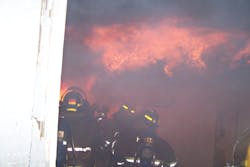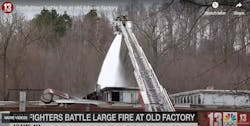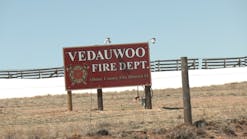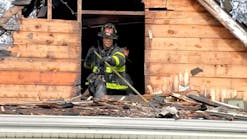How many times have you heard the old adage of firefighting is an inherently dangerous and physically demanding business? The truth is firefighters face countless potentially life-threatening challenges, some created by our own doings, while engaged in everyday work activity, including burn injury, asphyxiation, collapse and entrapment. The physiological consequences that threaten fire fighters is less recognized and appreciated. The combination of strenuous work, heavy and encapsulating personal protective equipment (PPE), hot and hostile conditions, and high adrenaline levels lead to significant levels of cardiovascular and thermal strain during firefighting activities.
Live fire training is necessary in order to prepare fire fighters for the dangerous and challenging environments in which they are expected to perform. Live fire training, however, is itself quite dangerous because it requires fire fighters to train in high heat environments with live fire conditions and immediately dangerous to life and health atmospheres. These intense training sessions can create high levels of cardiovascular and thermal strain, increasing the risk for heat related injuries and sudden cardiac events. Fire instructors, in particular, are often exposed to severe heat conditions for prolonged periods of time. Let face it we sometimes don’t know when to take a break and rehab ourselves. The exposure to such severe conditions creates a challenging and potentially dangerous situation for both the instructors and the students for whom they are responsible. It is important that the risks to fire trainees and fire instructors are managed effectively, so that the risks do not outweigh the benefits gained.
From firefighter to chief officer, volunteer or career, instructor, training officer or whatever your title or role may be; if you have been assigned to participate in or lead a training exercise that will involve any form of live fire, you have a responsibility to the people you will train, lead, or supervise. This responsibility precipitates from a number of sources. First and foremost, there is the moral obligation that comes with putting people in danger. There are also legislative responsibilities, which could be state laws, local codes, national industry standards and even the possibility of criminal charges for acts that could be considered from malicious or negligent. Then there is specter of a civil law threat.
You know that students learning to become firefighters, have died or been severely injured during live fire training exercises. However, you also know that unprepared firefighters are a threat to those they serve and /or serve with. You also have your colleagues telling you to make sure that the drill is “real”. They want to make it worth their time so the rookies can “learn something from it”. Their is also a fine line between real and dangerous. We must maintain the level of professionalism and not cross over to macho-self entertainment where we see who can take the most heat or get their helmet smoked or burned the most. These training events need to be that, events where sound practices are taught and enbraced teaching safe concepts and modern tactics.
So you have to achieve a balance of risk in training versus the risk of not having that training. NFPA 1403 was designed to set standards on what should be done to mitigate those dangers and that risk. We see time and time again in near misses, injury reports and when a line of duty death occurs, NIOSH reports the errors and omissions of sound practices based upon NIMS, NFPA 1403 and other basic functionality that did not occur. In this piece we want to provide you with support materials and information to make your live fire training exercises safe, compliant and objective driven.
When considering live fire training, safety should be the first and foremost concern of all involved. The training environment is the one area in which the instructor can control is the type of structure being used, the amount of fuel, and the evolutions to be performed. NFPA 1403 provides guidelines that aid the instructor in assuring that training is performed in a safe environment. It should be noted that NFPA 1403 provides the minimum requirements for training in live fire conditions. The Authority Having Jurisdiction (AHJ) has the ability to make more stringent rules and I encourage this, however they should not adopt a practice or procedure that is less than the minimum requirements.
Student Preparation
It is important to have student that are participating in any exercise with live fire be trained to the NFPA 1403 requirements. Prior to being permitted to participate in live fire training evolutions, the student shall have received training to meet the job performance requirements for Fire Fighter I in NFPA 1001, Standard for Fire Fighter Professional Qualifications, related to the following subjects:
· Safety
· Fire behavior
· Portable extinguishers
· Personal protective equipment
· Ladders
· Fire hose, appliances, and streams
· Overhaul
· Water supply
· Ventilation
· Forcible entry
The following job performance requirements from NFPA 1001 should be used as guidance related to the list of subjects in (4.1.1) (also, 5.1.1, 6.1.1, 7.1.1, 8.1.1):
· 5.2.3 Radio use
· 5.3.1 SCBA
· 5.3.4 Forcible entry
· 5.3.6 Ground ladders
· 5.3.7, 5.3.8 Fire extinguishment
· 5.3.9 Search and rescue
· 5.3.10 Structural fire fighting
· 5.3.11 Horizontal ventilation
· 5.3.12 Vertical ventilation
· 5.3.13 Overhaul
· 5.3.15 Water supply
· 5.3.16 Fire extinguishers
· 5.3.17 Scene illumination
· 5.5.1 Tool maintenance
· 5.5.2 Fire hose care and maintenance
Students participating in a live fire training evolution who received the required minimum training specified in from other than the authority having jurisdiction shall present written evidence of having successfully completed the prescribed training prior to being permitted to participate in any live fire training evolution.
Instructors
According to NFPA 1403, an instructor is an individual qualified by the authority having jurisdiction (AHJ) to deliver firefighting training, who has the training and experience to supervise students during live fire training evolutions. From there, the AHJ should use NFPA 1041, Fire Service Instructor Professional Qualifications, to start the process in determining if an instructor has the proper training and experience to supervise students in a live burn evolution. There is a difference between the learning environment and an emergency incident. There should be no surprises while performing a live burn evolution.
An inexperienced or untrained instructor can cause potential mishaps in a live fire training session. Failure to have true situational awareness about the entire event especially the areas you are responsible for and the impact of others actions can be detrimental to the training event. It is important that we look to seasoned and experienced instructors to lead these type of training exercises and pairing less experience individuals with these experience instructors as apprentices. Untrained or otherwise unprepared instructors have contributed to injuries and even fatalities in live fire training events. NFPA 1403 nor NFPA1041 are clear on the specific requirements to become a fire service live fire training instructor, so there is not a standard of what needs to known to be a live fire training officer. A number of regional or local training centers, as well as several states, have training programs to regulate this. The program in the state of Florida is legally required for all instructors participating in live fire training, and even requires state issued instructor certification in addition to the training course. The International Society of Fire Service Instructors (ISFSI) has also put out a Live Fire Instructor Certification. For more details visit www.isfsi.org.Below are several more documents that can be used in your preparations for a live fire training event.







